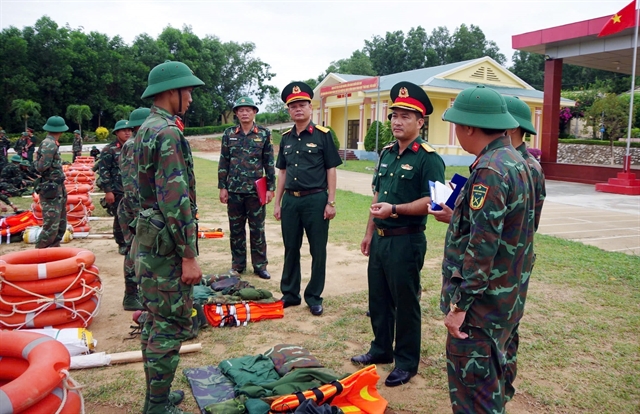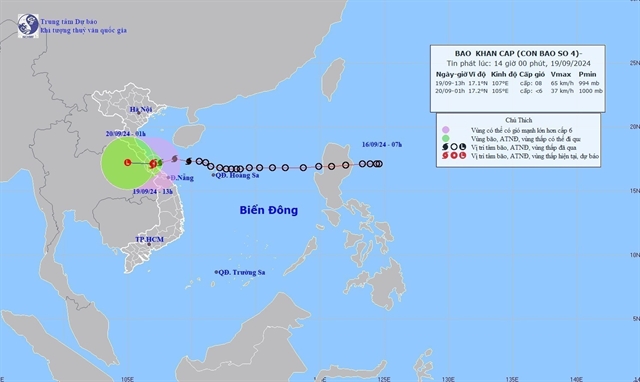PM tells local areas to be ready to respond to Typhoon Soulik, residents not to be complacent
Society – Economy - Ngày đăng : 16:54, 19/09/2024
 |
| The Provincial Military Command of Quảng Bình Province is ready to respond to the typhoon Soulik.—VNA/VNS Photo |
HÀ NỘI — Prime Minister Phạm Minh Chính has told the People’s Committees in the central provinces and cities to quickly deploy plans for responding to Typhoon Soulik, which weakened as a tropical depression on Thursday afternoon, ensuring the safety of lives and minimising damage to citizens’ property.
The directive was issued in an official dispatch to the Party secretaries and chairs in Thanh Hóa, Nghệ An, Hà Tĩnh, Quảng Bình, Quảng Trị, Thừa Thiên Huế, Đà Nẵng, Quảng Nam, Quảng Ngãi and Bình Định, as well as to relevant ministries.
He tasked the heads of the provinces and cities to implement response measures that align with the actual developments in their areas, proactively addressing the worst-case scenarios that may arise.
The tasks include guiding fishing vessels to avoid or exit dangerous areas, or to seek safe harbours and taking immediate measures to ensure the safety of vessels and equipment in mooring areas, as well as activities in coastal waters, particularly aquaculture farms, tourist sites and coastal service areas. They should implement measures to limit damage to housing, offices, schools, healthcare facilities, businesses, dikes, dams and construction sites, especially transportation projects and incomplete dikes.
Additionally, they must proactively arrange forces and equipment, particularly in areas expected to be directly affected by the typhoon and flooding to be ready to respond in emergencies.
The Minister of Agriculture and Rural Development has been asked to establish a 24/7 monitoring system to oversee the situation, proactively urge localities to implement appropriate response measures and report any matters exceeding their authority to the Prime Minister and Deputy Prime Minister.
The Minister of Transport was required to ensure safety measures for vessels operating at sea and on rivers, maintain road, rail and air transport safety and implement measures to protect people, vehicles, and significant national infrastructure projects currently under construction in the region.
Ministers of Industry and Trade, and Agriculture and Rural Development were told to closely collaborate with the local authorities to ensure safety, and the scientific operation of hydropower and irrigation dams to protect infrastructure and help mitigate downstream flooding.
The Ministers of Defence, and Public Security were required to instruct rescue forces to be on standby, ready to assist citizens, protect property and respond to other emergencies.
The Vietnam News Agency, Việt Nam Television and Voice of Việt Nam, along with other media outlets, had to increase their broadcasts to provide the public with accurate and timely information about the developments of the typhoon.
In a relevant move, the Ministry of Education and Training asked the directors of education and training departments in the 17 provinces and cities to consider closing schools when necessary, particularly in areas vulnerable to storm impacts.
The move aims to ensure the absolute safety of students, teachers and education staff during the storms.
Do not be complacent
 |
| The direction of the typhoon Soulik.— VNA/VNS Photo |
The typhoon, internationally named Soulik, formed on Thursday morning from a tropical depression over the north-eastern area of the Hoàng Sa Archipelagos. However, it had weakened as a tropical depression again on Thursday afternoon.
The National Centre for Hydro-Meteorological Forecasting said that as of 10am on Thursday, the typhoon’s eye was located over coastal waters from Quảng Bình Province to Thừa Thiên Huế Province, with maximum wind speeds reaching level 8 (62-74 km/h).
Due to the impact of the typhoon and its residual effects, torrential rains are expected in the provinces from Hà Tĩnh to Quảng Ngãi, with the rainfall from 100 to 300mm, with some areas exceeding 500mm.
Thanh Hóa and Nghệ An are forecasted to receive between 70 to 150mm, with isolated areas likely to exceed 250mm.
There is a high risk of flooding in low-lying areas along rivers, as well as flash floods and landslides on the slopes in the mountainous regions from Thanh Hóa Province to Thừa Thiên Huế Province.
Deputy head of the Disaster Response and Recovery Department under Việt Nam Disaster and Dike Management Authority, Nguyễn Xuân Tùng, said “Although the typhoon has slightly weaker winds than Typhoon Yagi, residents should not be complacent, as this could lead to unfortunate consequences. People must not underestimate the typhoon's intensity.”
He further noted the importance of being vigilant regarding post-storm rainfall and flooding.
He also warned about flash floods and landslides could occur in mountainous areas, particularly in Thanh Hóa, Nghệ An, Hà Tĩnh, Quảng Bình, Quảng Trị and Thừa Thiên Huế.
Deep flooding might occur in Hà Tĩnh Province and along the rivers in Quảng Bình, Quảng Trị, and Thừa Thiên Huế provinces.
Director of the National Centre for Hydro-Meteorological Forecasting, Mai Văn Khiêm, said “Despite the typhoon being classified as a level 8 storm, residents in affected areas must remain alert.”
The typhoon’s circulation covered a vast area, impacting not only the central north and central south regions directly but also extending to other areas such as the southern part of the Red River delta, Central Highlands and the southern region.
Within the adverse weather system, thunderstorms and strong gusting winds could happen at any time.
“We have repeatedly stressed that the strong gusts associated with thunderstorms can be even more dangerous than those of a severe typhoon.
"This poses significant risks for activities at sea and along the coast, particularly in areas where vessels are moored and aquaculture is practised. So, people must not underestimate the impacts of this level 8 typhoon,” he said.
Initial damages
In Quảng Trị Province, heavy rains, which were triggered by the typhoon, caused disruptions to transport in several areas within the mountainous districts of Đakrông and Hướng Hóa on Thursday.
In Đakrông District, flooding at crossings reached up to half a metre, affecting routes such as A Ngo - A Bung, Tà Rụt - A Ngo, Ly Tôn and Làng Cát.
In Hướng Hóa District, some crossings were submerged by up to a metre of water, isolating areas including Cooc Hamlet in Hướng Linh Commune, Loa and Trùm villages in Ba Tầng Commune.
By midday on Thursday, the provincial Steering Committee for Disaster Prevention and Search and Rescue reported that heavy rains occurred with rainfall levels ranging from 80 to 140mm.
The rainfall levels even reached 223mm in La Tó, 195.8mm in Tà Long and 152.8mm in Ba Nang in Đakrông District.
Authorities in the province warned that continued heavy to very heavy rains were expected until the end of Friday, with total rainfall of between 100 and 220mm, exceeding 300mm in some areas.
A flood alert was anticipated, with water levels on local rivers expected to reach levels 1 to 2.
In Quảng Bình Province, between Wednesday and Thursday morning, heavy rains were reported in the mountainous border districts of Minh Hóa and Tuyên Hóa.
Rising water levels in streams in Dân Hóa and Trọng Hóa communes led to localised flooding.
Due to the typhoon's impact, Tam Kỳ City in Quảng Nam Province experienced heavy rain on Wednesday, resulting in flooding on numerous streets, causing problems for residents and transport.— VNS
